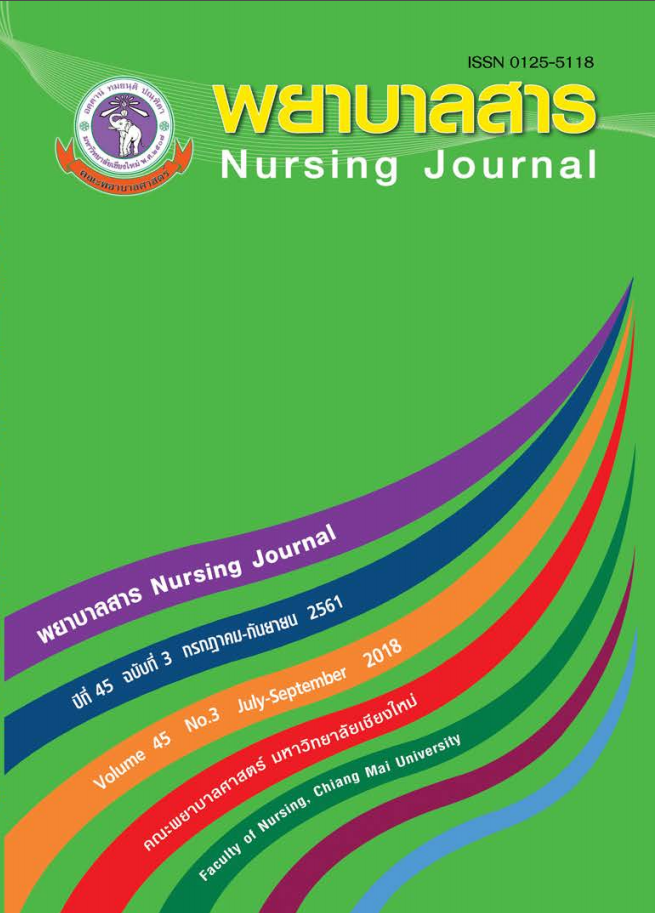Effectiveness of lmplementing Clinical Practice Guidelines for Palliative Care in Cancer Patients
Keywords:
effectiveness, palliative care, cancer patients, satisfaction, quality of lifeAbstract
Cancer is an incurable and life threatening disease. The major goal of healthcare services is to cure the cancer, to enable the patient to live longer, and to relieve their symptoms. Palliative care should be given throughout a patient’s experience with cancer, not only at the end of life. This operation research aimed to study the effectiveness of implementing the Nursing Clinical Practice Guideline on Palliative Care (NCPGPC) among cancer patients. The sample of this study composed of 150 persons with cancer admitted to the inpatient wards at a cancer hospital. Seventy-four of the participants were pre-implementation group and 76 were post-implementation group. The study took place for 8 months. The research instruments for data collection developed by the researchers included 1) the personal data form, 2) the checklist of advance care plan, 3) the satisfaction with care received questionnaire, and 4) the quality of life questionnaire. These questionnaires were validated by 5 experts and the content validity index was .90, .97, and .90 respectively. The reliability of the research instruments was tested with 10 patients that had the similar characteristics with the sample. The Cronbach alpha reliability was .83, .97 and .84 respectively. The framework for guideline implementation was modify from the National Health and Medical Research Council of Australia (NHMRC, 1999). Data were analyzed using descriptive statistics and independent t-test.
The study results revealed that:
- The percentages of the subject in the NCPGPC implementation performed activities of advance care plan higher than the pre-NCPGPC implementation group.
- The percentage of the subject in the post-NCPGPC implementation group reported high satisfaction with care received higher than the pre- NCPGPC group.
- The percentage of the subject in the post-NCPGPC implementation reported good level of quality of life higher than the pre- NCPGPC implementation group.
- The mean scores of satisfaction with care received of subject in the post-NCPGPC implementation were significantly higher than the pre- NCPGPC implementation group (t = -846, p <.01) and the mean scores of perceive quality of life of the subject in the post-NCPGPC implementation was not significantly higher than the pre- NCPGPC implementation group (t = .074, p < .05).
The findings of this study can confirm the effectiveness, feasibility, and meaningfulness of NCPGPC implementation among cancer patients. Nurses can use this guideline as a tool of for persons who need palliative care.
References
Fegg, M.J., Wasner, M., Neudert, C. & Borasio, G.D. (2005). Personal values and individual quality of life in palliative patients. Journal of Pain and Symptom Management, 30(2), 154-159.
Finlay, I.G. & Wheatley, V.J. (2008). Ethical issues in palliative care. Medicine, 36(2), 111-113.
Griffith, K.A., McGuire, D.B. & Russo, M. (2010). Meeting survivors’ unmet needs: an integrated framework for survivor and palliative care. Seminars in Oncology Nursing, 26(4), 231-242.
Medves, J., Godfrey, C., Turner, C., Paterson, M., Harrison, M., MacKenzie, L., & Durando, P. (2009). Practice guideline dissemination and implementation strategies for healthcare teams and team-based practice: a systematic review. JBI Library of Systematic Reviews, 7(12), 450-491.
National Health and Medical Research Council [NHMRC]. (1999). A guideline to the development, implementation and evaluation of clinical practice guideline. Retrieved from http://www.nhmrc.gov.au/_files_nhmrc/publications/attachments/nh56.pdf.
National Health and Medical Research Council [NHMRC]. (2000). How to put the evidence into practice: Implementation and dissemination strategies. Retrieved form https://www.nhmrc.gov.au/_files_nhmrc/publications/attachments/cp71.pdf
World Health Organization [WHO].) 2002). WHO definition of palliative care. Retrieved from http://www.who.int/cancer/palliative/definition/en/
World Health Organization [WHO]. ) 2008). Global burden of disease 2004 update. Retrieved from http://www.who.int/healthinfo/global_burden_disease/GBD_report_2004update_full.pdf.
Translated Thai Reference
Nantachaipan, P. & Soiwong, P. (2012). Clinical Nursing Practice Guideline: Palliative Care in Adult Patients. Bangkok: Judthong Company. (in Thai).
National Health Assembly. (2008). Health Act 2008. Retrieved from http://www.nationalhealth.or.th/sites/default/files/upload_files/ hpp_act_ebook58_08_07_453.pdf. (in Thai).
Strategy and Planning Devision. (2008). (2012). Health Statistics. Retrieved from http://bps.ops.moph/ .go.th/index.php?mod=bps&doc=5. (in Thai).
Downloads
Published
How to Cite
Issue
Section
License
บทความที่ได้รับการตีพิมพ์เป็นลิขสิทธิ์ของวารสารพยาบาลสาร
ข้อความที่ปรากฏในบทความแต่ละเรื่องในวารสารวิชาการเล่มนี้เป็นความคิดเห็นส่วนตัวของผู้เขียนแต่ละท่านไม่เกี่ยวข้องกับมหาวิทยาลัยเชียงใหม่ และคณาจารย์ท่านอื่นๆในมหาวิทยาลัยฯ แต่อย่างใด ความรับผิดชอบองค์ประกอบทั้งหมดของบทความแต่ละเรื่องเป็นของผู้เขียนแต่ละท่าน หากมีความผิดพลาดใด ๆ ผู้เขียนแต่ละท่านจะรับผิดชอบบทความของตนเองแต่ผู้เดียว






